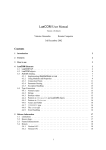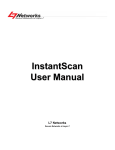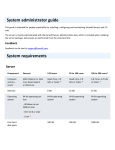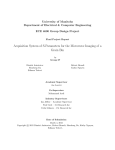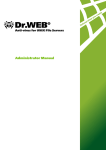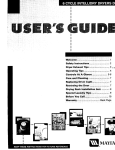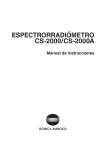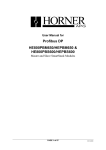Download Mótsognir server`s user manual
Transcript
Last update: 12 Jul 2015
Motsognir – The mighty gopher server
User manual
Written by Mateusz Viste
http://motsognir.sourceforge.net
gopher://gopher.viste.fr/1/projects/motsognir/
Motsognir gopher server's manual - Table of Contents
Table of Contents
Introduction..................................................................................................................................... 3
Installation...................................................................................................................................... 4
Configuration file............................................................................................................................ 5
Directory listings............................................................................................................................. 9
Gophermaps.................................................................................................................................. 10
Files listing............................................................................................................................... 10
Sub-gophermap scripts.............................................................................................................. 11
Per-user gopher directories............................................................................................................ 12
CGI support................................................................................................................................... 13
Let's see how CGI works..........................................................................................................13
How to enable CGI support in Motsognir.................................................................................14
PHP support.................................................................................................................................. 15
How to enable PHP support in Motsognir.................................................................................15
Example.................................................................................................................................... 15
Caps.txt support............................................................................................................................ 16
Serving different content on multiple domain names....................................................................17
Security considerations.................................................................................................................18
Run Motsognir as a non-privileged (non-root) user..................................................................18
Choose your file permissions wisely.........................................................................................18
Use paranoid mode if you are (really) paranoid........................................................................18
Trap the daemon inside a chroot jail.........................................................................................18
Frequently asked questions (FAQ)................................................................................................20
Legal mumbo-jumbo..................................................................................................................... 21
Page 2 / 21
Motsognir gopher server's manual - Introduction
Introduction
Motsognir is a robust, reliable and easy to install open-source gopher server for Unix-like
(POSIX) systems. Motsognir is a standalone daemon that supports server-side CGI applications
and PHP scripts, is plainly compatible with UTF-8 filesystems, and is entirely written in ANSI C
without external dependencies. It supports both IPv4 and IPv6 'out of the box', without requiring
any special configuration.
Gopher is a distributed document search and retrieval network protocol designed for the
Internet. Its goal is to function as an improved form of Anonymous FTP, enhanced with
hyperlinking features similar to that of the World Wide Web.
I wrote Motsognir primarily for fun, but it appears to have become a strong, full-featured
gopher server implementation with some very nice points: easy to install, lightweight, portable,
secure...
The Motsognir gopher server is meant to be used for small projects (like home servers), but
should scale well on bigger architectures as well. All the configuration is done via a single
configuration file, which has very reasonable defaults. That makes Motsognir easily maintainable,
and allows the administrator to have full knowledge of what features are allowed/enabled on the
server.
Page 3 / 21
Motsognir gopher server's manual - Installation
Installation
Installing Motsognir is very easy on most systems, since it comes packaged as a part of the
operating system on many Linux and BSD distributions. However, if your operating system
doesn't have a plug & play motsognir package, then you will have to install it manually.
In the first place, you will have to build it. Assuming you have the basic GNU development
tools installed (make, gcc), building Motsognir should be as straight-forward as:
# make
This will generate a 'motsognir' executable. You will need to install it on your system, then:
# make install
Now, all you have to do is edit your /etc/motsognir.conf file to make it suit your needs, and
then launch motsognir:
# /usr/sbin/motsognir
Note: If you wish to store the motsognir.conf file outside of /etc/, or under a different
filename, this is possible as well, but you will have to instruct motsognir about its location every
time your run it:
# /usr/sbin/motsognir --config /my/custom/location/motsognir.conf
Alternatively, you could also modify the default location of the configuration file at compiletime, using the -DCONFIGFILE=/etc/somefile.conf parameter.
Page 4 / 21
Motsognir gopher server's manual - Configuration file
Configuration file
Motsognir's configuration file is located by default in /etc/motsognir.conf (unless the default
location has been modified at compile-time using the -DCONFIGFILE define), and should be
readable by the user which will run the motsognir service. The configuration file is a plain-text
file, containing some tokens with values. All lines beginning with the "#" character are ignored
(and can be used to put some comments in the configuration file).
If any of the parameter is missing from the configuration file, or have an empty value,
Motsognir will use a default value instead. Here below is an example of a self-explanatory
configuration file.
##############################################################
#
#
#
CONFIGURATION FILE FOR THE MOTSOGNIR GOPHER SERVER
#
#
#
##############################################################
## Server's hostname ##
# The hostname the gopher server is reachable at. This setting is highly
# recommended, because the gopher protocol is heavily relying on
# self-pointing links. If not declared, the server's IP address will be used
# instead.
#GopherHostname=gopher.example.com
## Gopher TCP port ##
# The TCP port on which the public Gopher server listens on.
# Usually, gopher servers are published on port 70. Default: 70.
GopherPort=70
## Bind on IP address ##
# Set this 'bind' parameter to the IP address you'd like Motsognir to listen
# on. Note, that this parameter must be either an IPv6 address, or an IPv4
# address written in IPv4-mapped IPv6 notation (for ex. "::FFFF:10.0.0.1").
# If not specified, Motsognir will listen on all available IP addresses.
# This setting might be useful if you have a multihomed server, and you would
# like to serve different content for each IP address.
# Examples:
# bind=2001:DB8:135:A0E3::2
# bind=::FFFF:192.168.0.3
bind=
## Root directory ##
# That's the local path to Gopher resources. Note, that if you use
# a chroot configuration, you must provide here the virtual path
# instead of the real one.
# The default path is /var/gopher/
GopherRoot=/var/gopher/
Page 5 / 21
Motsognir gopher server's manual - Configuration file
## User home directories ##
# If you'd like to serve gopher content from user directories, using the
# classic /~user/ URL scheme, then define the user directories location here
# below. The configured location must contain a '%s' tag, which will be
# substituted with the username by motsognir. This must be an absolute path.
# If nothing is configured, then support for serving content from user
# directories won't be available. Example:
# UserDir=/home/%s/public_gopher/
UserDir=
## chroot configuration ##
# If you'd like to put Motsognir inside a chroot jail, configure here
# the chroot directory that shall be used.
# By default no chroot is used.
chroot=
## Paranoid mode ##
# For paranoidal security, you might want to enable "Paranoid mode". In this
# mode, Motsognir accepts to serve only files with permissions set to "world
# readable".
# Possible values: 0 (disabled) or 1 (enabled). Disabled by default.
ParanoidMode=0
## Activate the verbose mode ##
# Here you can enable/disable the verbose mode. In verbose mode,
# Motsognir will generate much more logs. This is useful only in
# debug situations.
# Possible values: 0 (disabled) or 1 (enabled). Disabled by default.
Verbose=0
## CGI support ##
# The line below enables/disables CGI support. Read the manual
# for details.
# Possible values: 0 (disabled) or 1 (enabled). Disabled by default.
GopherCgiSupport=0
## PHP support ##
# There you can enable PHP support.
# Possible values: 0 (disabled) or 1 (enabled). Disabled by default.
GopherPhpSupport=0
## Sub-gophermap scripts ##
# If you'd like to use sub-gophermap scripts in your gophermaps, set
# SubGophermaps.
# Possible values: 0 (disabled) or 1 (enabled). Disabled by default.
SubGophermaps=0
## Secondary URL-delimiting char
# By default, only the '?' char is recognized as a delimiter between an
# object and the query that must be run on the object. With this parameter,
# you can define an additional character that will be equivalent to '?'. This
# character must be provided in a numerical form, as an ASCII value.
# Example for the hash (#) character:
# SecUrlDelim=35
SecUrlDelim=
Page 6 / 21
Motsognir gopher server's manual - Configuration file
## Run as another user ##
# If you start motsognir under a root account, you might want to configure
# it so it drops root privileges as soon as it doesn't need them anymore and
# switches to another user. This is recommended for increased security,
# unless you already run Motsognir as a non-root user.
# To do so, provide here the username of the user that Motsognir should run
# as. Default = no value.
RunAsUser=
## Default gophermap #
# If you wish that your server would use a default gophermap when displaying
# a directory that do not have a gophermap, you can specify here a path to
# the gophermap file you'd like to use.
DefaultGophermap=
## HTTP error file
# When Motsognir receives a HTTP request, it answers with a HTTP error,
# along with a html message indicating why it is wrong. If you'd like to use
# a custom html file, you can set it here. Note, that the specified file is
# loaded when Motsognir's starts. If you modify the file afterwards, you'll
# need to restart the Motsognir process for the file to be reloaded.
# Example: HttpErrFile=/etc/motsognir-httperr.html
HttpErrFile=
## Caps.txt support ##
# Caps.txt is a specific file-like selector, which allows a gopher client to
# know more about the server's implementation (for example what the path's
# delimiter is, where is the server located, etc). When enabled, Motsognir
# will answer with caps-compatible data to requests for "/caps.txt".
# Caps support is enabled by default (CapsSupport=1).
CapsSupport=1
## Caps additionnal informations ##
# If Caps support is enabled, you can specify there some additional
# informations about your server. These informations will be served
# to gopher clients along with the CAPS.TXT data.
# Example:
# CapsServerArchitecture=Linux/i386
# CapsServerDescription=This is my server
# CapsServerGeolocationString=Dobrogoszcz, Poland
# CapsServerDefaultEncoding=UTF-8
CapsServerArchitecture=
CapsServerDescription=
CapsServerGeolocationString=
CapsServerDefaultEncoding=
## Extension to filetype mapping ##
# Motsognir looks at file's extensions to advertise the proper gopher resource
# type. If the default mapping is not suiting you, you can load a custom
# mapping using a separate configuration file called an 'extmap', and declare
# it below. The extmap file is a simple text file, where every line provides
# a mapping for a single file extension, in such format:
# txt:0
# pdf:P
# gif:g
Page 7 / 21
Motsognir gopher server's manual - Configuration file
# Note: Extensions in the extmap file are processes in a case-insensitive way.
ExtMapFile=
# [End of file here]
Page 8 / 21
Motsognir gopher server's manual - Directory listings
Directory listings
As any other gopher server, Motsognir will present to gopher clients listings of available
directories with a specific presentation. A specific requirement of the Gopher protocol is that it
needs to provide a "type" for every resource. To detect that gopher type, Motsognir is simply
basing on the file's extension. Below is a table containing the default relations between gopher
filetypes and real file extensions, as used by Motsognir:
Gopher type
Description
Files binded to this gopher type
0
Plain text file
*.txt
1
Directory listing
All directories
2
CSO search query
-
3
Error message
-
4
BinHex encoded text file
-
5
Binary (PC-DOS) archive file
-
6
UUEncoded text file
-
7
Search engine query
-
8
Telnet session pointer
-
9
Binary file
All files which doesn't fit into any other
category
g
GIF image file
*.gif
h
HTML file
*.htm, *.html
i
Informational message
-
I
Image file (other than GIF)
*.jpg, *.jpeg, *.png, *.bmp, *.pcx, *.ico,
*.tif, *.tiff, *.svg, *.eps
s
Audio file
*.mp3, *.mp2, *.wav, *.mid, *.wma, *.flac,
*.mpc, *.aiff, *.aac
P
PDF file
*.pdf
M
MIME encoded message
-
;
Video file
-
Note, that the above relations can be overwritten using a custom extension mapping
('extmap') file, declared within Motsognir's configuration file using the ExtMapFile directive.
Example:
ExtMapFile=/etc/motsognir.extmap
Page 9 / 21
Motsognir gopher server's manual - Gophermaps
Gophermaps
There are situations when you would like to have the absolute control on how the server will
display a directory. That's why Motsognir supports gophermaps. If Motsognir finds a file called
"gophermap" (without any extension) in a directory, then it doesn't check the directory content,
and simply outputs to the user the content of the gophermap. Note, that if you enable CGI and/or
PHP support, Motsognir will also look for respectively gophermap.cgi and gophermap.php files.
A gophermap file contains gopher entries as described by the RFC 1436. There's an example of a
gophermap file (of course <tab> have to be replaced by real tabs):
iWelcome to my gopher server!<tab>fake<tab>null<tab>0
i<tab>fake<tab>null<tab>0
0About my server<tab>/about.txt<tab>mygopher.domain.net<tab>70
1Download<tab>/download<tab>mygopher.domain.net<tab>70
1A link to a friend's server<tab><tab>friend.domain.net<tab>70
hMy Website<tab>URL:http://mywebsite.com<tab><tab>
You can omit the server's address and server's port parts in your gophermap files (unless
these are dynamically generated via CGI or PHP). If you don't specify a port, Motsognir provides
the one your server is using (usually 70). If you don't specify a host, Motsognir provides your
server's hostname. If you specify a relative selector (not beginning by a / character) instead of an
absolute path, Motsognir sticks on the path of the currently browsed directory (but only if the host
part is omitted, or pointing to your own server).
Therefore, a simpler form of the above gophermap could look like that:
iWelcome to my gopher server!
i
0About my server<tab>about.txt
1Download<tab>download
1A link to a friend's server<tab>friend.domain.net<tab>70
hMy Website<tab>URL:http://mywebsite.com
Files listing
A specific feature of Motsognir regarding gophermap files is its ability to generate a dynamic file
listing inside a gophermap, using a special %FILES% directive. Example:
iWelcome to my gopher server!
i
0About my server<tab>about.txt
i
iBelow are all the files I have in this directory:
%FILES%
i
Page 10 / 21
Motsognir gopher server's manual - Gophermaps
iEnjoy!
Motsognir provides you with a feature that allows you to set a server-wide gophermap to be
used by any directory that do not have its own gophermap. This is the 'default' gophermap. The
default gophermap have to be declared in the Motsognir's configuration file, via the
'DefaultGophermap' directive.
Sub-gophermap scripts
Another feature of Motsognir is its ability to run scripts from within existing gophermaps.
Such scripts are called “sub-gophermap scripts”, because they are supposed to output a partial
gophermap that will be inserted into our actual gophermap. A sub-gophermap script must be
declared in the gophermap with a '=' gopher type. Here below is an example of how such subgophermap script would be called:
iHello, World! My current uptime is:
=/bin/gopher-uptime.sh
i
Note, that for sub-gophermap scripts to run, Motsognir must be configured to allow their
execution, via the SubGophermaps configuration directive:
SubGophermaps=1
Page 11 / 21
Motsognir gopher server's manual - Per-user gopher directories
Per-user gopher directories
On systems with multiple users, each user can be permitted to have public gopher content in
their home directory using the UserDir directive. Visitors to a URL like
gopher://example.com/~username/ will get content out of the home directory of the user
"username", out of the subdirectory specified by the UserDir directive.
Note that, by default, access to such per-user directories is not enabled. You can enable
access when using UserDir by setting a line like this:
UserDir=/home/%s/public_gopher/
Note, that the UserDir configuration must obey a few rules:
- it must be an absolute path (ie. it has to begin with a '/'),
- it must contain a '%s' tag. This tag is replaced with the username by Motsognir.
Page 12 / 21
Motsognir gopher server's manual - CGI support
CGI support
Motsognir supports CGI application, which allows to run custom scripts and applications
interacting with the gopher client.
Let's see how CGI works.
Each time a client requests the URL corresponding to your CGI program, the server will
execute it in real-time, then the output of your program will go more or less directly to the client.
In fact, when it comes to answer to the client, the CGI application will output a gopher response
(ie. a plain text file for file type #0, a directory listing for file type #1, etc...). This response will
be catched by Motsognir, and forwarded to the gopher client as being the request's answer.
The Motsognir gopher server provides some information to the CGI application, by setting
some environment variables. Note, that for security reasons – and unlike some other CGI
implementations - Motsognir will never feed CGI scripts with any command-line parameters.
Motsognir will set several environment variables, which can be read by the called CGI script.
Here is the complete list of these variables:
QUERY_STRING
QUERY_STRING_URL
QUERY_STRING_SEARCH
SERVER_SOFTWARE
SERVER_NAME
GATEWAY_INTERFACE
REMOTE_ADDR
REMOTE_HOST
SCRIPT_NAME
SERVER_PORT
The URL parameters or query, as provided by the client
The client's URL parameter
The client's search query
The name and version of the server software
The server's hostname, DNS alias, or IP address, used
for self-referencing links
The revision of the CGI specification, as supported by
the server
The IP address of the remote client
Same as REMOTE_ADDR
Script name (for self-referencing links)
The port number to which the request was sent
Note, that the QUERY_STRING variable will contain data inputed by the user. For type #7
items, it will contain the search string (on type #7 items, the gopher client usually asks the user
for a query, using some kind of pop-up). For any other item's type, the QUERY_STRING
variable will contain the part of the URL after the first "?" character (if any). For example, for a
request on "gopher://mygopher.server.com/0/myprog.cgi?hellothere", the QUERY_STRING
variable will contain the data "hellothere".
It is also possible to use search items (type #7) with a "?" URL - in such case, the CGI script
will be able to read both queries separately via QUERY_STRING_URL and
QUERY_STRING_SEARCH.
Page 13 / 21
Motsognir gopher server's manual - CGI support
How to enable CGI support in Motsognir
If you would like to use CGI applications on your Motsognir server, you will have to enable
CGI support in the Motsognir's configuration file (GopherCgiSupport = 1). You will also have to
make sure that your CGI programs use the extension *.cgi.
Page 14 / 21
Motsognir gopher server's manual - PHP support
PHP support
PHP is a scripting language that is very popular in the web world. You can use it with gopher,
as well. Motsognir provides PHP support since its v1.0. The PHP concept is very similar to CGI
(historically, PHP was in fact born as a set of custom CGI scripts), therefore you are advised to
read the chapter about CGI first. Most of it applies to PHP, too.
The main difference is that instead of trying to directly execute PHP files, Motsognir will
feed them to your system's php interpreter, and collect the result.
To pass data to your PHP application, you will have to rely on the QUERY_STRING
environment variable.
How to enable PHP support in Motsognir
First of all, make sure that php is available on your system. Then, simply enable the
parameter in Motsognir's configuration file (GopherPhpSupport = 1). Note, that all your php files
must have the extension *.php to be recognized by Motsognir.
Example
Here below is a simple example of a PHP file that could be used as a dynamic (PHP)
gophermap with Motsognir.
<?php
echo
echo
echo
echo
echo
echo
"iHello, this is a php-driven gophermap\tx\tx\t0\r\n";
"i\tx\tx\t0\r\n";
"iCurrent date is " . date(DATE_RFC822) . "\tx\tx\t0\r\n";
"iServer powered by {$_SERVER['SERVER_SOFTWARE']}\tx\tx\t0\r\n";
"i\tx\tx\t0\r\n";
"1Go back\t\t{$_SERVER['SERVER_NAME']}\t{$_SERVER['SERVER_PORT']}\r\n";
?>
Page 15 / 21
Motsognir gopher server's manual - Caps.txt support
Caps.txt support
Motsognir supports caps.txt since version 0.99.1. Caps.txt is a file-like selector, which allows
a gopher client to know more about the server's gopher implementation (like what is the path
delimiter character, how are structured server's paths, what the server's location is, etc).
Caps.txt support is configurable via the Motsognir's configuration file, using following
tokens:
## Caps.txt support ##
# Caps.txt is a specific file-like selector, which allows a gopher client to
# know more about the server's implementation (for example what the path's
# delimiter is, where is the server located, etc). When enabled, Motsognir
# will answer with caps-compatible data to requests for "/caps.txt".
# Caps support is enabled by default (CapsSupport=1).
CapsSupport=1
## Caps additionnal informations ##
# If Caps support is enabled, you can specify there some additional
# informations about your server. These informations will be served
# to gopher clients along with the CAPS.TXT data.
# Example:
# CapsServerArchitecture=Linux/i386
# CapsServerDescription=This is my server
# CapsServerGeolocationString=Dobrogoszcz, Poland
CapsServerArchitecture=
CapsServerDescription=
CapsServerGeolocationString=
If you would like to have full access to what Motsognir sends in Caps.txt data, then you
might consider disabling the caps.txt support in Motsognir (CapsSupport=0), and simply host
your own caps.txt file in the server's root. Here is an example of such custom caps.txt file:
CAPS
CapsVersion=1
ExpireCapsAfter=3600
PathDelimiter=/
PathIdentity=.
PathParent=..
PathParentDouble=FALSE
PathKeepPreDelimeter=FALSE
ServerSoftware=Motsognir
ServerSoftwareVersion=1.0
ServerArchitecture=Linux/i386
ServerDescription=This is my gopher server
ServerGeolocationString=Dobrogoszcz, Poland
Page 16 / 21
Motsognir gopher server's manual - Serving different content on multiple domain names
Serving different content on multiple domain names
You have your gopher server up and running, and now you'd like to make use of several
different domain names on it – and on each domain, different content should be served. In the http
realm such thing is called “virtual hosting”. The gopher protocol, however, doesn't have any
provision for a similar mechanism. This doesn't mean that all hope is lost, though.
To work out the above situation, you will need to have multiple different IP addresses
assigned to your gopher server (fortunately since IPv6 stepped in, having as many addresses as
we need is not a problem anymore). Once this is done, then it's only a matter of 'binding' every
one of your gopher domain names to a different IP address. The final step is running a dedicated
instance of Motsognir on every IP address.
Example
Let's imagine that I own two domains: gopher.example.com and gopher.mydomain.net. For
these domains, I'd like to serve gopher content from /srv/gopher.example.com/ and
/srv/gopher.mydomain.net/, respectively.
Step 1: configure at least two different IP addresses on my gopher server, and declare them
within my DNS zone to be used like this:
2001:DB8:410E:ABC::1 → gopher.example.com
2001:DB8:410E:ABC::2 → gopher.mydomain.net
Step 2: Prepare two different configuration files for Motsognir, with different “bind” and
“GopherHostname” settings, like this:
/etc/motsognir-gopher.example.com.conf
GopherHostname=gopher.example.com
bind=2001:DB8:410E:ABC::1
...
/etc/motsognir-gopher.mydomain.net.conf
GopherHostname=gopher.mydomain.net
bind=2001:DB8:410E:ABC::2
...
Step 3: Run two instances of Motsognir, using your custom configuration files:
motsognir --config /etc/motsognir-gopher.example.com.conf
motsognir --config /etc/motsognir-gopher.mydomain.net.conf
Page 17 / 21
Motsognir gopher server's manual - Security considerations
Security considerations
Like with any unix daemon, there are a few security aspects that one should always keep in
mind. Even the most carefully written programs can have bugs, some of which could be exploited
by malicious persons. This is the reason why a system administrator should apply some security
limitations even to simplest or most trusted daemons.
Run Motsognir as a non-privileged (non-root) user
A system daemon is usually not supposed to be run as root. In the (unlikely!) situation where
an attacker would gain control over Motsognir, having the process running as an unprivileged
user would greatly reduce the panel of harmful actions that could be performed on your server.
However, there is a problem: you will usually want to run your gopher server under the standard
TCP/70 port...and this being a low port requires the process to have root privileges. That's why
Motsognir provides a special configuration option called 'RunAsUser'. This option allows to set
the username we'd like Motsognir to use, and then, when Motsognir will be launched, it will first
open (“bind”) the listening port, and only then drop its privileges to switch to the configured user.
Choose your file permissions wisely
If your Motsognir server runs as a non-privileged user, then it makes much sense to limit
permissions on files that it serves. If the gopher server is not supposed to modify a file, this file
should be set as 'read-only' and owned by root. This way, even if Motsognir becomes
compromised, it still won't be able to modify these files.
Use paranoid mode if you are (really) paranoid
By default, Motsognir will happily serve anything that is located somewhere in the gopher
root path, and that is readable by the gopher-running user. To make things even more strict, you
might want to use Motsognir's “Paranoid mode” (configurable in Motsognir's configuration file).
In this mode, Motsognir will accept to serve only files that have “world readable” permissions
set.
Trap the daemon inside a chroot jail
The principle of a chroot jail is simple: run a process inside a 'virtualized' environment with a
modified root path (for example, mapping a chroot / on /srv/gopher/). This technique is used to
make it impossible for the process to access any file outside the chroot jail. A process can need
Page 18 / 21
Motsognir gopher server's manual - Security considerations
some files, like shared libraries, or configuration files, to run properly. If chrooting a process, one
would need to put all these files into the chroot as well (and the process' executable file itself!).
To avoid these problems, Motsognir provides a 'chroot' configuration parameter that, once set,
will make Motsognir run, load its configuration, and only then perform a chroot to the designated
directory.
Note, that if you use any kind of dynamic files (*.cgi or *.php), you will need to take care to
put all dependencies of these applications inside the chroot jail, too. This includes a shell at
/bin/sh, all system libs that your applications might require, etc. Often a working /proc will also
be needed.
Page 19 / 21
Motsognir gopher server's manual - Frequently asked questions (FAQ)
Frequently asked questions (FAQ)
Q: Does Motsognir support special (nationalized) character sets in file names?
A: Yes, it does. Motsognir implements support for UTF-8 encoded URLs, therefore it is able to
handle any existing language. Note, that it requires the local server's filesystem to be using
UTF-8 too, otherwise only the basic ASCII set will be handled.
Q: Can I use Motsognir for commercial purpose, or adapt it to my own needs?
A: Yes, you definitely can. Motsognir is released under the GNU/GPLv3 license, therefore
everyone is free to use it, modify it, and even sell it. However, you can't claim that you are the
author of this software, and you must provide the source code of any modification you do on
it (and you can't EVER drop the GPL licensing). Note, that if you add any feature or fix to
Motsognir, I would be happy to add your code to the official release.
Q: Is there any way to run server-side applications on Motsognir?
A: Motsognir supports executable CGI scripts, as well as PHP files. Both of these technologies
allow you to run custom server-side scripts.
Q: What's the maximum file size that Motsognir can serve?
A: Motsognir itself can serve files which are up to 8 exbibytes (EiB) big. However, there are
chances that your filesystem will limit you much sooner (for example EXT3 supports files up
to 2 TiB of size, while EXT4 supports files up to 16 TiB).
Q: What does "Motsognir" stand for?
A: In Norse mythology, Mótsognir is the father of the Dwarves. Mótsognir is the creation of
Odin and his brothers, Vili and Vé, who fashioned him out of Ymir's blood and bones in the
form of a maggot. He got a roughly humanoid appearance and a human-like intelligence,
which the rest of the Dwarves later inherited. (source: wikipedia)
Q: Does Motsognir support the HTTP protocol?
A: No. Motsognir is a gopher server. Gopher is a protocol different from HTTP. However, if you
send by mistake a HTTP request to Motsognir (for example using a URL like
http://yourserver:70/), he will politely answer to you with a HTTP error message, explaining
what the mistake was.
Q: Is this a real 'FAQ'?
A: No, I totally made up most of these questions.
Page 20 / 21
Motsognir gopher server's manual - Legal mumbo-jumbo
Legal mumbo-jumbo
Copyright © Mateusz Viste 2008-2015
http://motsognir.sourceforge.net
gopher://gopher.viste.fr/1/projects/motsognir/
All rights reserved. This product or documentation is protected by copyright and is
distributed under licenses restricting its use, copying, distribution and decompilation. See the
GNU General Public License as published by the Free Software Foundation, either version 3 of
the License, or (at your option) any later version for details.
The copyright owner gives no warranties and makes no representations about the contents of
this manual and specifically disclaims warranties of merchantability or fitness to any purpose.
The copyright owner reserves the right to revise this manual and to make changes from time
to time in its content without notifying any person of such revision or changes.
Graphic images
The image of the dwarf on the cover of this manual is based on the original work of Lorenz
Frølich (1820-1908).
Trademarks
Unix is a registered trademark of UNIX System Laboratories, Inc. Windows, WindowsNT,
and Win32 are registered trademarks of Microsoft Corp. All other product names mentioned
herein are the trademarks of their respective owners.
Page 21 / 21






















